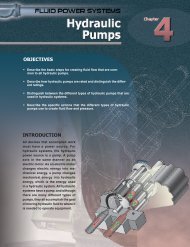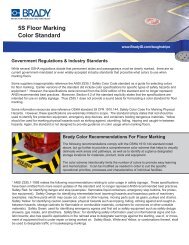POWER UP A WINNER - Plant Services
POWER UP A WINNER - Plant Services
POWER UP A WINNER - Plant Services
You also want an ePaper? Increase the reach of your titles
YUMPU automatically turns print PDFs into web optimized ePapers that Google loves.
Reliability / Piping<br />
the stub-end. These back-up flanges often are metallic and the<br />
stub-end design yields a contact area comparable to that of a<br />
raised-face flange. These assemblies can generate significantly<br />
higher compressive stresses than flat-faced flanges.<br />
Elastomer gaskets might appear to be the obvious solution<br />
to low-load flanges. They’re suitable for some flanges types,<br />
but compressive loads are typically too high when using<br />
glass-lined or stub-end flanges. Moreover, elastomer gaskets<br />
aren’t always compatible with system media. PTFE-based<br />
gaskets provide chemical compatibility, but require higher<br />
loads to seal effectively.<br />
The message is that you should calculate the available<br />
compressive stress for a given flange when selecting a gasket<br />
or troubleshooting a leak. If the available stress falls between<br />
More often than not, flanged joint<br />
gasket failures derive from the<br />
meCHanics of the aPPlication.<br />
600 psi and 1,200 psi, a rubber gasket will work. If the calculated<br />
stress is below 600 psi, you might need special gaskets<br />
to maintain a consistently tight, leak-free seal. By contrast, a<br />
stress greater than 1,200 psi might crush and split a rubber<br />
gasket, but still might be too low to produce an effective seal<br />
with harder materials, such as rubber-bound fiber sheet gaskets<br />
or standard PTFE-type materials. These materials work<br />
best at stresses of 3,000 psi or more.<br />
Gasketing for low-load flanges<br />
For extremely low-load flanges, consider rubber-based<br />
gaskets with molded ridges that concentrate the compressive<br />
load (Figure 3). These gaskets often seal where standard rubber<br />
sheet gaskets leak. They achieve a tight<br />
seal more easily because the ridges contact<br />
the flanges first. As more compressive load<br />
is applied, larger areas of the flange come<br />
in contact with the gasket, preventing<br />
it from being crushed, even though the<br />
initial contact area is limited.<br />
These gaskets can be beefed up with<br />
metal backing rings that slip behind the<br />
flanges to provide more joint strength.<br />
The rings permit greater bolt torque that<br />
produces a significantly larger pressure<br />
capability. These bolted joints can survive<br />
pressures that nearly equal the burst pressures<br />
of the piping.<br />
There are many soft, highly compressible<br />
PTFE-based gaskets that collapse to 20% to<br />
40% of their original thickness. This, technically,<br />
makes these materials softer than<br />
Water power<br />
TOPIC<br />
Gasket tutorial<br />
Figure 4. This gasket reacts with water or<br />
oil to generate its own load, eliminating<br />
leaks in low-load applications.<br />
more resources at www.plantservices.com<br />
Joint sealants<br />
searCH<br />
“Rethinking the purchase of valves<br />
and valve repairs”<br />
“Joint sealants to the rescue”<br />
For more, search www.<strong>Plant</strong><strong>Services</strong>.com using the<br />
keywords flange, gasket and load.<br />
some rubber gaskets, but they still require minimum compressive<br />
stress to seal the leak paths through the gasket body. Some<br />
flange types noted above can produce sufficient compression<br />
on these gaskets, but others, especially non-metallic flat-faced<br />
flanges, might not consistently seal using these gaskets.<br />
One possible alternative is an elastomer gasket with a<br />
PTFE envelope that wraps around the inside diameter and<br />
a portion of the gasket face. The envelope can be affixed to<br />
the rubber with an adhesive or bonded to the rubber during<br />
vulcanization.<br />
Another solution to a low-load situation is a gasket that<br />
swells in the contained liquid (Figure 4). These gaskets<br />
typically are of the fiber variety, and are less compressible<br />
than rubber gaskets. The advantage of a fiber gasket is that it<br />
handles low loads and withstands stresses that would crush<br />
a rubber gasket. A secondary advantage is the availability of<br />
sheet sizes to 150 in. square, making it possible to use a onepiece<br />
gasket in very large flanges.<br />
Another advantage of fiber-based gasket material with<br />
swelling characteristics is its ability to be used with flatfaced<br />
flanges when the operating pressure or, in some cases,<br />
the test pressure, is too high for a rubber gasket. The higher<br />
pressure rating of the fiber gasket allows the joint to function<br />
reliably at elevated pressures, while the swelling seals<br />
the flat-faced flanges.<br />
Compressive load has an enormous<br />
effect on the performance of gasketed<br />
joints in industrial piping systems.<br />
Available bolt loading is a critical factor<br />
in determining the type of gaskets<br />
to be used. Many types of gasket material<br />
and designs are available to meet<br />
the challenges posed by various flange<br />
configurations. Keeping your gasket<br />
supplier involved in the selection and<br />
replacement process will help your<br />
plant’s piping systems perform reliably,<br />
efficiently and sustainably.<br />
David Burgess is senior applications engineer<br />
for Garlock Sealing Technologies, Palmyra,<br />
N.Y. Contact him at dave.burgess@<br />
garlock.com and (315) 597-4811.<br />
www.PLANTSERVICES.com APRIL 2009 37












